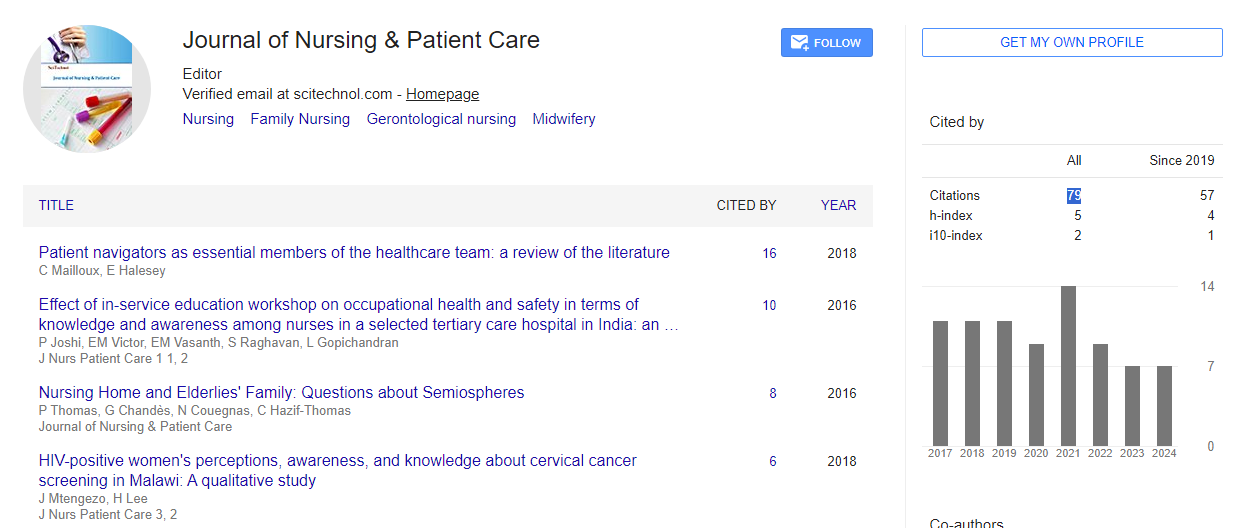Breast tumor of papillary lesion in palliative care: new insight
Shinya Tajima
National Hospital Organization Shizuoka Medical Center, Japan
: J Nurs Patient Care
Abstract
In woman’s nursing and palliative care, breast cancer is a world-threatening disease so important for treatment of nursing. In the breast tumor especially papillary lesions reveal broad range from benign to malignant. If pathologists can accurately diagnose benign, reduce unnecessary operation. However pathologists tend to sometimes over-diagnosis in papillary lesions. Here, we would like to present new concept of two papillary lesions at a glance benign. In the past, lacking myoepithelial cells is thought to be invasion and means malignancy. Two cases of 68- (Case1) and 44-year-old (Case2) female are presented. They have abnormality in the breast. And they came to the hospital for further examination and treatment. Radiologically, malignancy could not completely exclude. Then, breast excision was performed. Histologically, both cases revealed papillary lesions lined by fibro vascular core and nuclear inverse-polarity without atypia. Loss of myoepithelial cells was observed by HE, p63, and calponin. Previous report indicate CK5/6, ER, p63 and MUC3 are important for distinguishing between papillary lesions according to the differential index (based on Allred score) of ([ER total score] + [MUC3 total score])/([CK5/6 total score] + [p63 total score] + 1). Based on this analysis, our 2 cases had benign lesions. Additionally, the Ki-67 index was <1% in both cases, and no evidence of disease was observed minimum 62 months of follow-up for both cases, despite lack of additional treatment. Thus, we propose these lesions accurately benign and contributing woman’s nursing and palliative care for reducing operation. These lesions are reported and named “Nuclear inverse polarity papillary lesion lacking myoepithelial cells”. However, the name is too long and its distinctiveness and rareness, someone think this tumor as “Tajima tumor” by the advocator. Thus we can contribute to woman’s health and palliative care by the viewpoint of pathological knowledge.
References :
1. Molecular subtypes of breast cancer in South Asian population by immunohistochemical profile and Her2neu gene amplification by FISH technique: association with other clinicopathologic parameters. Hashmi AA, Edhi MM, Naqvi H, Khurshid A, Faridi N. Breast J. 2014; 20:578–585.
2. Prognostic parameters of luminal A and luminal B intrinsic breast cancer subtypes of Pakistani patients. Hashmi AA, Aijaz S, Khan SM, et al. World J Surg Oncol. 2018;16:1.
3. Ki67 index in breast cancer: correlation with other prognostic markers and potential in pakistani patients. Haroon S, Hashmi AA, Khurshid A, Kanpurwala MA, Mujtuba S, Malik B, Faridi N. Asian Pac J Cancer Prev. 2013;14:4353–4358.
Biography
Shinya Tajima had graduated from Keio University School of Medicine, he was employed as a staff to Department of Pathology at Keio University School of Medicine. There he learned pathological anatomy and diagnostic pathology. After two years, he belong to Department of Radiology at St. Marianna University School of Medicine to study breast imaging. And he have presented some scientific exhibitions about radiopathological correlation of the breast in domestic and international congress. Furthermore, he learned at St. Marianna University Graduate School of Medicine for four years. And after PhD of radiolo-pathology was acquired, now he is doing some research about the comparison of pathologic features and radiologic imaging findings and also using pathological knowledge as a staff of St. Marianna University School of Medicine Department of Pathology and Radiology. Now, he is interested in breast diagnostic pathology, breast radiologic pathology and working as a staff in National Hospital Organization Shizuoka Medical Center.
 Spanish
Spanish  Chinese
Chinese  Russian
Russian  German
German  French
French  Japanese
Japanese  Portuguese
Portuguese  Hindi
Hindi 